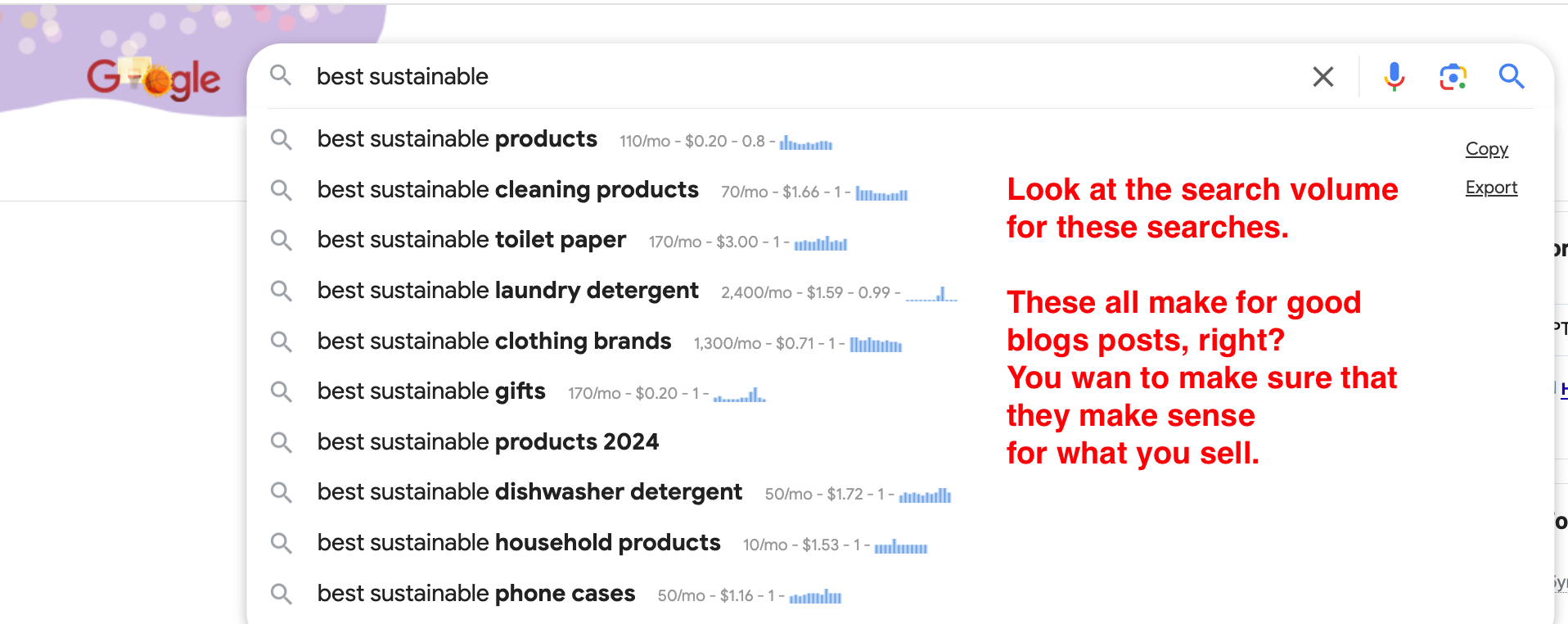
Here’s a quick test:
Go to Google and type in “best [insert your product or category]”—whatever it is you sell.
For example:
- Best sustainable products
- Best zero-waste gifts
- Best organic skincare brands
- Best reusable kitchen items
Now, ask yourself:
Did your brand show up on the first page?
If not—and your competitors did—then you have a problem.
When your brand doesn't appear, you're not just missing exposure. You're losing credibility, authority, and most importantly—sales. If someone else keeps showing up as the “best,” that’s who your potential customers will trust and buy from.
Let’s use one of our Inner Circle member, Mudd House Mercantile, as an example. They sell high-quality, eco-friendly sustainable products. But when you search “best sustainable products” on Google, they're not showing up on page one in the search results—while some of their competitors do.
They have a strong brand, loyal customers, and great products—but in Google’s eyes, they’re not yet the go-to.
So, what can brands like Mudd House do to at least get in the runnings?
Know What People Are Actually Searching For
Find specific, long-tail keywords your audience actually types in. For example:
- “best sustainable cleaning products”
- “best sustainable gifts”
Optimize Your Website for Those Exact Terms
You can’t rank for something you never mention.
- Add target keywords to title tags, meta descriptions, H1s, and product copy.
- Build individual product and collection pages around high-intent search phrases.
- Make sure your site is fast, mobile-friendly, and secure.
The following queries show up in Search Console for Mudd House Mercantile and point to her "Living" collection page. But here’s the issue—the actual search terms don’t appear anywhere on that page.
So what’s the fix?
Start by adding those exact queries to the page content. Simple, but effective.

Create Blog Content That Matches Search Intent
If someone’s searching “best sustainable products,” write a blog post titled:
“10 Reusable and Sustainable Products for the Home”
Make sure the content:
- Features your own products
- Compares benefits and use cases
- Includes internal links back to your collections
Listicles like this are easy to digest and rank well when optimized properly.

Get Featured and Build Backlinks
Google trusts sites that other quality sites link to.
- Pitch your brand to bloggers and creators in the eco-space
- Write guest posts on related websites
- Submit to curated articles like “Top 10 Eco-Friendly Brands” or “Best Sustainable Products for Minimalist Living”
Get Listed on Google Business and Local Directories
Even if you’re an eCommerce-only brand, setting up your Google Business Profile, Yelp listing, and appearing on eco directories gives you local SEO credibility.
Track Your Progress
Use:
- Google Search Console to see which search terms you're showing up for
- Google Analytics to track who’s coming to your site and from where
- Make updates based on actual performance—not assumptions.
Hopefully this post was useful.
How We Work
In Mastering P.o.P’s membership, each member has a customized SEO strategy that they are actively executing. For any online business owner with a website, having a clear SEO strategy is important—it helps attract the right audience, rank well in search results, and drive traffic to the site. As part of this strategy, we track 100 keywords for each member. These keywords are carefully selected based on competitors performing well with them, alignment with our product offerings, and the expected traffic they can generate.
Members regularly receive tips like these within the community and during weekly Zoom calls, which are recorded, timestamped, and organized with agendas to make the guidance clear and actionable. Learn How We Work!

